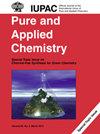Ozone-initiated degradation of 1,2-dichlorobenzene over ceria-supported manganese, nickel, vanadium and iron catalysts
IF 2
4区 化学
Q3 CHEMISTRY, MULTIDISCIPLINARY
引用次数: 0
Abstract
Oxidative degradation of 1,2-dichlorobenzene using different loadings of metal (Mn, Ni, V, and Fe) supported on CeO在铈支撑的锰、镍、钒和铁催化剂上臭氧引发的 1,2-二氯苯降解
研究人员使用 CeO2 上不同负载的金属(锰、镍、钒和铁)对 1,2 二氯苯进行了氧化降解。所有负载金属(锰、镍、钒和铁)的 CeO2 催化剂都是用湿法浸渍法合成的,合成后的催化剂材料用不同的分析仪器,如 FT-IR、SEM-EDX、XRD、BET、ICP-OES 和 TEM 方法进行了表征。在 24 小时内,通过孔隙率为 2 的多孔鼓泡器将底物(1,2-二氯苯)与臭氧(0.0794 毫克/升)一起鼓泡到玻璃反应器中,研究了 1,2-二氯苯的氧化反应。使用气相色谱-质谱法对氧化产物进行了鉴定,并使用傅立叶变换红外光谱法对臭氧氧化产物中的官能团进行了研究。已确定的臭氧氧化产物为 mucochloric acid 和 3,4-二氯-2,5-呋喃二酮。所有负载在 CeO2 催化剂上的 V 在臭氧处理(24 小时)结束时都产生了 100%的短氯酸。
本文章由计算机程序翻译,如有差异,请以英文原文为准。
求助全文
约1分钟内获得全文
求助全文
来源期刊

Pure and Applied Chemistry
化学-化学综合
CiteScore
4.00
自引率
0.00%
发文量
60
审稿时长
3-8 weeks
期刊介绍:
Pure and Applied Chemistry is the official monthly Journal of IUPAC, with responsibility for publishing works arising from those international scientific events and projects that are sponsored and undertaken by the Union. The policy is to publish highly topical and credible works at the forefront of all aspects of pure and applied chemistry, and the attendant goal is to promote widespread acceptance of the Journal as an authoritative and indispensable holding in academic and institutional libraries.
 求助内容:
求助内容: 应助结果提醒方式:
应助结果提醒方式:


